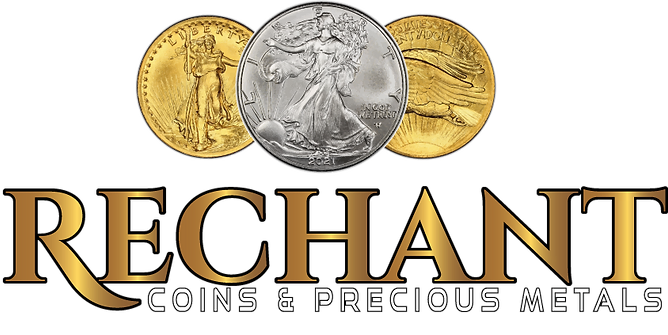Gold Bullion Market Trends 2025 Price Prediction
The gold bullion market in 2025 is poised to see significant activity, reflecting economic uncertainties and investor preferences. Inflation and fluctuating interest rates continue to shape the demand for gold, solidifying its position as a reliable safe-haven asset.
Amid these developments, Rechant Coins & Precious Metals, a well-established coin dealer in West Palm Beach serving South Florida since 1975, has reported growing interest in physical gold products.
The influence of
central bank buying patterns and limited mining outputs could further escalate the price of gold.
Investors in South Florida, attracted to accessible bullion options, should evaluate these market trends while leveraging expert insights for smart decision-making.
“Global uncertainties and monetary policies will likely drive gold demand, making 2025 a pivotal year for savvy investors. ”
Click here to learn more about: for sale now
Future Gold Price Forecast
Analyzing the future gold price involves examining key historical data and economic indicators. Predictive models underscore gold’s resilience during financial crises, particularly against inflation and instability in the United States Dollar.
Experts at Rechant Coins anticipate that central bank policies and global trade tensions could support gold price prediction trends through As a tangible asset, gold is regarded as a hedge against economic uncertainties.
South Florida's market aligns with these global patterns, showing an increase in demand for both
physical gold and collectible coins.
Investors should stay vigilant, leveraging insights on macroeconomic factors to forecast price movements with greater confidence.
Key Drivers Shaping Gold’s Value
- Inflation: Higher inflation often leads to increased gold demand.
- Monetary Policies: Central bank decisions can significantly influence gold prices.
- Geopolitical Events: Trade tensions and economic instability impact global gold demand.
- Market Sentiment: Investor confidence in gold affects long-term price trends.
Actionable Insights for South Florida Investors
Rechant Coins emphasizes the importance of monitoring gold price trends and leveraging local market expertise. By keeping an eye on price charts and demand indicators in South Florida, buyers can navigate evolving market conditions effectively. Whether it's diversifying portfolios or securing gold bullion as a hedge, local investors are well-positioned to take advantage of opportunities in Partnering with trusted dealers ensures access to competitive rates and expert guidance for a successful investment.
This version incorporates bolded SEO keywords seamlessly while maintaining the article's readability and flow.
Exploring the Dynamics of the Gold Market: Key Drivers and Central Bank Influence
Gold demand is influenced by unique cultural, economic, and technological factors, giving it an enduring appeal to both collectors and investors. From the active bullion markets in South Florida to the significant role of central banks worldwide, understanding these dynamics is essential for navigating the ever-evolving gold market.
This section explores the economic considerations, regional trends, and global strategies shaping the gold bullion market, offering insights for numismatists and investors alike.
Factors Driving Gold Demand
Gold stands as a cornerstone of the global economy, driven by a combination of cultural traditions, economic trends, and emerging technologies.
Each of these elements contributes to shaping the demand for gold worldwide and impacts its availability locally, especially in active markets such as South Florida.
Here’s a deeper look at the factors steering the bullion market trends and their implications for collectors and investors.
Cultural and Regional Influences
The cultural diversity in regions like South Florida creates a unique marketplace for gold. Gold jewelry and collectible coins often hold significant sentimental and traditional value among various communities.
Annual festivities and familial milestones frequently spark a higher demand for gold jewelry, particularly for physical gold, leading to price fluctuations in the global market. Local collectors, influenced by these traditions, actively participate in the global gold market, emphasizing the importance of rare coins and bullion items.
Economic Considerations
Periods of economic uncertainty and inflation drive many investors to gold as a hedge against market volatility.
The price of gold often reacts to shifts in monetary policy, interest rates, and currency fluctuations, such as movements in the United States dollar, Euro, or Japanese Yen.
For instance, during the 2007–2008 financial crisis, gold gained prominence as an investment asset for those seeking stability.
The adoption of gold in portfolios is further supported by its role as a safe-haven asset, especially during uncertain market conditions.
Technological Advancements
Advances in gold refining, authentication processes, and even tokenized trading platforms have streamlined the ability to buy, sell, and store bullion. Tools such as price charts and moving averages offer investors data-backed strategies to predict and capitalize on market trends.
In South Florida, where the bullion market remains robust, these technologies enable collectors and traders to stay informed about price movements and forecasted trends, such as the gold price prediction for 2025.
Role Of Central Banks In Gold Market
Central banks wield significant influence over the precious metals market, particularly due to their strategies for acquiring and diversifying gold reserves. These actions not only stabilize global trade but also trickle down into local markets, impacting collectors and small-scale investors.
Let’s examine how central banks shape the future of gold markets and the opportunities this creates in regions like South Florida.
Gold as a Reserve Asset
Central banks hold gold as a safeguard against uncertainties in the financial system.
By doing so, they provide stability within the global gold market.
The need to hedge against inflation and mitigate currency risks—especially those involving the United States dollar—has driven banks to expand their gold reserves. For instance, nations such as China have amplified their gold holdings, adding to the ongoing bull market in the gold bullion market.
Market Impact on Collectors
When central banks adjust their gold policies, there’s a direct ripple effect on bullion prices.
This can influence the purchasing power of collectors and numismatists, particularly in active hubs like South Florida. For example, price changes due to significant asset acquisitions by central banks often attract more local buyers who wish to diversify their investments.
Local shops, such as Rechant Coins, provide guidance on navigating these market trends effectively, ensuring collectors make informed purchasing decisions.
“Forecasting the gold market may rely on technical analysis, but collectors in South Florida understand the importance of timing and long-term investment strategies. Central bank actions often set the tone for these decisions. ”
Diversification Strategies
Central banks are increasingly turning to gold to diversify their reserves, reducing reliance on fiat currencies and mitigating geopolitical risks.
This shift has spurred interest in gold bullion trading across global and local markets. Collectors and investors in South Florida can benefit from these market shifts by exploring fractional ownership of physical gold and carefully monitoring tokenized physical gold trading options — innovations that make buying gold easier for all levels of numismatists.
By understanding the influence of central banks and cultural factors, numismatists and investors gain a strategic edge in the gold bullion market.
Whether it’s navigating price fluctuations, leveraging local expertise, or following global trends, staying informed is a pivotal part of success in the world of rare coins and precious metals.
the Gold Market
- Gold demand is influenced by cultural traditions, economic trends, and emerging technologies.
- Periods of economic uncertainty, such as the 2007–2008 financial crisis, increase gold's appeal as a safe-haven asset.
- Central banks significantly impact gold prices through their policies and reserve diversification strategies.
- Technological advancements, like tokenized trading platforms, have made gold trading more accessible to investors.
Unveiling the Dynamics of Gold: Policies, Crises, and Investment Strategies
Have you ever wondered how the price of gold fluctuates with global and local events? From the impact of monetary policies on gold markets to its role as a hedge against financial uncertainty, understanding these dynamics is essential for numismatists at any level. Discover how inflation control, interest rate adjustments, and economic crises drive the demand for gold bullion.
Let us guide you through these fascinating connections so you can make informed decisions in the gold bullion market.
Impact of Monetary Policies on Gold
The relationship between monetary policy and gold prices has long intrigued both investors and numismatists.
Policies designed to curb inflation, such as adjusting interest rates, create a ripple effect that shapes the global gold bullion market. For instance:
- Rising interest rates: When central banks, like the Federal Reserve, increase interest rates, the opportunity cost of holding a yield-free asset like gold rises. This often leads to a temporary dip in gold demand.
- Periods of high inflation: During times of steep inflation—such as the post-2007–2008 financial crisis—gold prices often rise sharply due to its role as a safe-haven asset.
Take the localized example of South Florida during economic instability. Here, higher inflation rates led to a surge in investments in physical gold, including fractional coins and bullion bars. For those of us navigating market trends closely, federal policy announcements provide critical insights. Recognizing these patterns early can profoundly influence how you trade or acquire gold bullion, whether it's a new interest rate hike or a global financial crisis.
Understanding the drivers of gold price fluctuations—from policy shifts to market sentiment—is key to building a strong investment strategy.
Gold as a Hedge Against Uncertainty
When markets falter, gold as an investment provides a shield against economic turbulence. Historical examples reinforce this dynamic:
- The 2007–2008 financial crisis saw an impressive 25% rise in the price of gold as investors turned to precious metals for stability.
- During Hurricane Irma in 2017, South Floridians increasingly turned to physical gold bullion to secure their assets amidst widespread uncertainty.
Geopolitical tensions and currency devaluations, such as fluctuations in the United States dollar, the Euro, and the Japanese yen, further highlight the enduring demand for physical gold. Whether you’re buying fractional coins or larger bullion bars, gold continues to serve as a reliable safe-haven asset.
For numismatists, anticipating these shifts is essential. Maintaining an adaptable inventory of gold bullion, including collectible coins, allows you to respond to evolving market conditions. Take note of price chart trends, technical analysis tools like the moving average, and global economic events that might propel the next bull market in gold prices.
Gold’s ability to retain value through financial crises and global tensions cements its role as one of the most dependable assets in modern markets.
Whether you’re investing in gold jewelry, bullion, or rare coins, the significance of gold in navigating uncertainty remains unmatched. Let’s explore these market forces together as we prepare for the evolving dynamics that will shape gold prices in the years to come.
Gold Market Dynamics
- Gold prices often rise during periods of high inflation, such as after the 2007–2008 financial crisis.
- Rising interest rates increase the opportunity cost of holding gold, potentially leading to a decrease in demand.
- Gold serves as a safe-haven asset during economic crises, geopolitical tensions, and currency devaluations.
- South Florida saw a surge in physical gold investments during Hurricane Irma due to widespread uncertainty.
Unlocking Insights on Gold Price Trends and Market Sentiment
The gold market, with its rich complexities and diverse influences, remains a central focus for investors, collectors, and dealers alike. This section delves into advanced technical analysis methods that help decode gold price movements and explores global and regional market sentiment about the precious metal.
Whether you're navigating the gold bullion market for investment opportunities or aiming to understand demand dynamics in South Florida and abroad, this guide offers essential strategies and insights.
Let’s journey through the fascinating ways to predict gold price trends and how cultural and economic factors shape global market sentiment on gold.
Technical Analysis of Price Movements
Forecasting the price of gold requires more than tracking headlines about interest rate changes or inflationary pressures.
It involves advanced techniques such as the Relative Strength Index (RSI) and Fibonacci retracements, which are useful for identifying market trends and potential reversals in the gold market. Here’s how these tools help refine predictions:
- RSI Insights: Gold price movements can drastically shift when the RSI indicates overbought or oversold market conditions. An RSI above 70 often signals that gold prices may be poised for a correction, while a value below 30 hints at undervaluation, presenting buying opportunities.
- Fibonacci Retracements: These levels, such as 2% or 8%, offer critical benchmarks for predicting support and resistance during price corrections. For instance, a gold price chart reflecting a bounce at key Fibonacci levels suggests potential recovery trends in the gold bullion market.
- Moving Averages: Identifying market entry or exit points becomes clearer using long-term moving averages. When the price of gold crosses above its 200-day average, it often signals a bullish phase, whereas a drop below it may indicate bearish sentiment.
Combining these techniques allows investors and dealers to adapt strategies effectively within a volatile bullion market. From forecasting the gold spot price to identifying future resistance levels, these advanced tools sharpen prediction accuracy, proving invaluable for traders in regions like South Florida and beyond.
Global Market Sentiment on Gold
The demand for gold bullion and jewelry varies significantly across geographical regions, driven by cultural preferences and economic circumstances. Let’s explore how market sentiment influences the purchasing trends in South Florida compared to global regions:
- South Florida: This region uniquely reflects its diverse cultural tapestry. Cities such as Boca Raton and Palm Beach see affluent buyers who view gold as an investment against financial crises and monetary policy shifts. The population’s Latin American and Caribbean influence boosts the demand for gold jewelry, often tied to traditions and celebrations.
- India: Gold remains an integral part of cultural milestones and festivities. The nation’s enduring demand for physical gold significantly contributes to global consumption, creating ongoing support for the bullion market.
- Europe: Many central banks, particularly in the Eurozone, hold substantial gold reserves as a hedge against currency volatility. This policy impacts global perceptions of gold as a safe-haven asset, increasing investor confidence during periods of uncertainty.
- Japan: Traditionally cautious investors in Japan often turn to gold during periods of prolonged low-interest rates, underscoring gold’s role as a stable long-term asset.
“South Florida’s unique demand for gold bullion reflects not just economic considerations but also a deep cultural connection that distinguishes it from global trends. ”
These variations in demand illustrate why market sentiment analysis is indispensable for making informed decisions about investments or inventory expansion. As dealers, recognizing these patterns allows tailoring strategies to cater to both local buyers and the broader global gold demand.
| Technical Analysis Techniques | Market Sentiment Insights |
|---|---|
| RSI above 70 may signal overbought conditions, while below 30 indicates undervaluation. | South Florida sees gold demand influenced by Latin American and Caribbean traditions. |
| Fibonacci retracements help predict support and resistance during price corrections. | India’s cultural milestones drive significant physical gold consumption globally. |
| Crossing above the 200-day moving average often signals a bullish phase. | Eurozone central banks hold gold reserves as a hedge against currency volatility. |
Unlocking Insights: Long-Term Trends in Precious Metals
For collectors and investors in South Florida, a nuanced understanding of gold, silver, and platinum's long-term performance is essential. Each metal plays a critical role in a portfolio, balancing growth, stability, and diversification.
Whether you're analyzing gold's historical resilience, silver's performance in industrial markets, or platinum's unique market position, this guide unveils trends that can shape your decisions.
Let’s explore how these precious metals behave over time, and their significance for savvy investors and numismatists alike.
Gold: The Steady Guardian of Wealth
Gold has long been the bedrock of global investment strategies, exhibiting unparalleled stability amidst economic upheavals.
The price of gold demonstrates a strong correlation with inflation, acting as a hedge when currencies like the United States dollar, the euro, or the Japanese yen lose value. Gold consistently attracts demand during periods of market uncertainty, evidenced by its significant price resilience during events like the 2007–2008 financial crisis.
Data suggests that gold's price is expected to rise steadily by 2025, driven by global inflationary trends and continued demand for bullion among central banks and investors.
For South Florida investors, gold price trends underline the value of acquiring physical gold bullion, such as coins or bars, due to their stability and liquidity. Historical price movements, analyzed through technical tools like moving averages, show that gold as an investment often remains favorable compared to riskier assets.
Strategic buyers can use gold price charts to identify opportunities during market dips, guided by predictions and insights from the World Gold Council.
Silver and Platinum: Opportunities in Growth and Diversification
Silver: The Dual-Role Performer
Silver, renowned for its industrial and investment applications, frequently surpasses gold in bull markets with rapid price escalations.
The metal's utility in technologies such as solar energy and electronics ensures robust demand, further amplified as the global economy pivots towards green initiatives.
Recent market trends indicate a supportive environment for silver price growth, particularly in industrial hubs.
Technical analysis reveals that silver's volatility offers opportunities for traders seeking short-term gains and long-term investors aiming for substantial growth.
Silver's fundamentals make it a dynamic asset for South Florida collectors, offering accessibility and a track record of outperforming during economic recoveries. Whether you're investing in silver bullion coins, bars, or rounds, its long-term prospects remain tied to industrial innovation and increasing renewable energy adoption worldwide.
Platinum: A Rare and Volatile Niche
Platinum, though lesser-known than gold or silver, plays a distinctive role in portfolios.
Its market sentiment often fluctuates due to limited supply and concentrated mining operations, primarily in South Africa. This rarity contributes to significant price fluctuations, making it a compelling choice for investors seeking niche diversification.
Analysts predict that platinum prices are expected to increase, fueled by demand in automotive and green hydrogen technologies, offering lucrative opportunities for collectors and investors
For South Florida's seasoned numismatists, acquiring platinum coins such as the American Platinum Eagle or fractional denominations could be valuable.
Its performance during periods of automotive innovation showcases its potential as both a financial hedge and an industrial catalyst.










